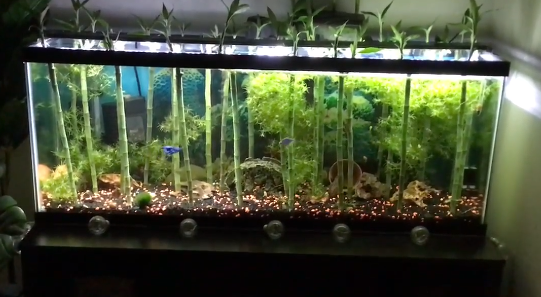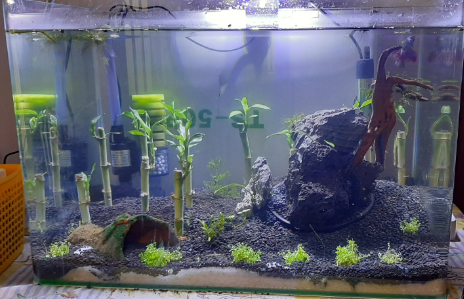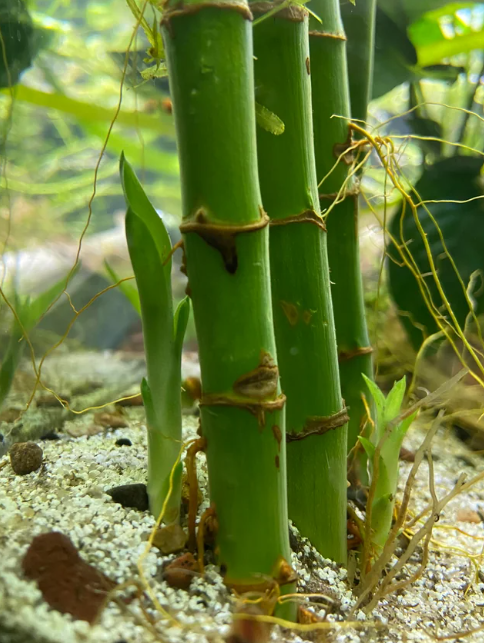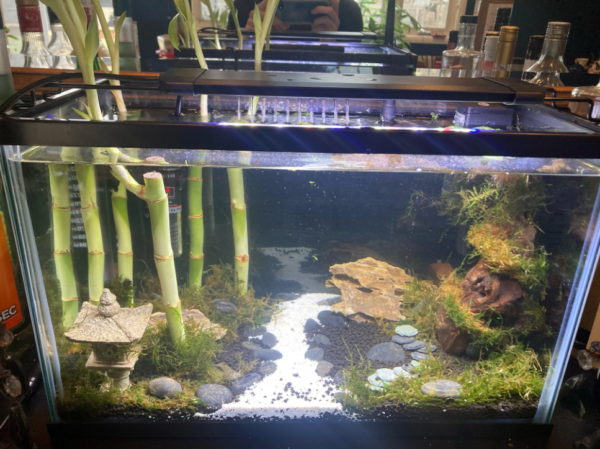Lucky bamboo helps you make a stunning underwater display in your aquarium, but can you grow it fully submerged in an aquarium like other aquatic plants? Will your fancy lucky bamboo plant become your new favorite aquarium addition, and is it safe for your fish?
Growing a lucky bamboo plant isn’t difficult, as long as you meet its basic needs and prepare to manage it with suitable pruning methods. You need to know these facts about the lucky bamboo plant and how to grow it in your aquarium successfully.
Table of Contents
Can Lucky Bamboo Safely Grow in an Aquarium?

Absolutely! Lucky bamboo is an excellent choice for your freshwater aquarium, terrarium, and fish pond. Some aquariums may not be the best choice to house a lucky bamboo, but for the most part, it thrives underwater and is gorgeous to look at.
What Is Lucky Bamboo?
Lucky bamboo is a grass-like member of the dracaena family, and it’s not a bamboo. You can bend and shape your lucky bamboo into crazy patterns with its thick, juicy stems. You’ve likely seen it at local garden centers with magnificent upward-spiraling shoots or weird zig-zag shapes. Adding a lucky bamboo to an underwater aquascape lets you create a beautiful, exotic display that will have all of your aquascaping friends drooling with envy.
The lucky bamboo (Dracaena sanderiana) is not some exotic plant from the Far East. Instead, it is from Central Africa’s watery plains in Cameroon. While it has the same features as bamboo with nodes and leafy growths on a thick stem, its unique characteristics are more like that of a type of grass, and it grows in pretty much the same way.
Because your lucky bamboo plant isn’t tree-like (like a regular bamboo), it usually has a shorter lifespan of about two years – as many grass species do.
Learn more about a time-saver planted aquarium.
Lucky Bamboo vs Regular Bamboo
Unlike regular bamboo, your lucky bamboo is actually more closely related to the asparagus family. Lucky bamboo is not even bamboo!
For starters, your lucky bamboo doesn’t grow nearly as fast as regular bamboo, nor does it reach the same heights, which is another reason why a lucky bamboo will fit into your aquarium without taking over.
Regular bamboo has a hollow stem, but your lucky bamboo grows a thick and fleshy stem, which allows you to shape the stem into unique patterns and forms.
Lucky bamboo has shallow roots and has adapted to growing fully or partially submerged in the floodplains of Africa, which is why it will thrive in your freshwater aquarium.
Does Lucky Bamboo Grow in Water or When Fully Submerged?
You can successfully grow lucky bamboo in your small five-gallon aquarium, and you can choose whether you want the whole plant underwater or just the stem with the leaves growing out the top in a grand display. When the whole plant is grown fully submerged, it creates a dense forest of lush green leaves that your fish will love.
To grow lucky bamboo in a tank, you should meet its nutritional and oxygen needs (but more on that later).
Benefits of Stocking Your Tank with Lucky Bamboo

So why add lucky bamboo to your aquarium? While it makes for a beautiful backdrop, it has several other benefits:
- Supports Your Tank Filtration
Lucky bamboo filters your tank water, helping convert the nitrites into harmless fertilizer the plant uses to grow. With cleaner water, your fish will also thrive, and it helps reduce the pressure on your filters.
- Playground for Your Fish
The fleshy solid stems of the lucky bamboo provide a fun obstacle course your fish can play among, helping to reduce stress.
- Hiding Spots for Your Young Fish
In a community tank with a diverse population, the lucky bamboo forests you create in your tank provide a fun place to hide from larger fish that could bully or predate them. Small fish and young fries can hide among the leaves and between the fleshy stems.
- Statement Pieces
Lucky bamboo forms a statement piece and is relatively easy to grow once the basics are in place. You don’t necessarily have to add anything else with a few lucky bamboo pieces in your tank.
The lucky bamboo stems and leaves quickly provide a healthy underwater ecology and make for an authentic view with a couple of colorful tropical fish swimming about.
Learn more about choosing the right plants for your aquarium.
Parameters for Growing Lucky Bamboo in Your Aquarium
Are you sold on the idea of adding lucky bamboo to your aquarium? Grab your lucky bamboo shoot, and let’s learn the how and what (as in what you need) to ensure your lucky bamboo thrives in your aquarium.
When you establish the correct parameters, your lucky bamboo quickly roots and thrives, and you’ll have fewer plant-care hassles along the way. Here’s what to look at:
1. Tank Dimensions
Most lucky bamboo plants come as small shoots when you order them. They may already have been pre-shaped or straight. While your lucky bamboo won’t grow as fast as actual bamboo, it can still reach an impressive four feet in height once it matures.
Your tank dimensions will significantly influence the health and appearance of your lucky bamboo. To fully submerge the mature plants, you would need a tank with a depth of around four feet, but you can also cultivate a few leafy shoots above the waterline, which creates a fun finish (as long as your tank doesn’t need a lid or cover).
As long as you don’t overdo it on fertilizer, the shoots will grow at a nicely manageable pace. With some minor pruning, you can ensure the lucky bamboo plants stay within the parameters of a fair-sized tank.
The smallest tank dimensions you should consider for housing lucky bamboo is a five-gallon tank to avoid the plant filling the tank.
2. Water pH
Your lucky bamboo thrives in waters with a pH of 6-6.5, so as long as your fish are happy in this pH range, your tank will work well. Don’t add lucky bamboo to an acidic or hard water tank, as it prefers slightly alkaline and softer water.
Also, remember that lucky bamboo is a freshwater plant that won’t grow in marine or blackwater tanks (with salty water).
3. Water Temperature
Lucky bamboo isn’t as temperature sensitive as some aquatic plants, and you can play in a range of 58℉-80℉. Ensure the temperature range remains fairly steady to encourage healthy leaf growth. Your lucky bamboo will grow pretty quickly with warmer temperatures and good fertilization.
4. Planting Medium
Some aquarists believe you don’t have to use a planting medium as your lucky bamboo draws most of its nutrients from the water as nitrates. However, to create a successful aquascape and stop the shoots from floating around in your aquarium, use a growth medium to anchor the shoots’ ends.
Depending on the fish in your aquarium, using small to medium-sized gravel makes the best substrate as it covers the little roots and prevents fish from nibbling on them. Soft growth mediums like sand or soil aren’t the best as they can easily bind to the small roots, causing rot and preventing the uptake of nutrients.
5. Nutritional Needs
The nutritional needs of your lucky bamboo will depend significantly on your tank’s dynamics. If you have a large fish population that produces large amounts of nitrites, you can probably get away without any extra fertilizers for your lucky bamboo.
Of course, with minimal fertilizing, your lucky bamboo will grow slowly and possibly not develop to its full potential. This could be an effective strategy in a smaller tank, but you would get extra CO2 fertilizer for larger tanks to encourage vigorous growth.
6. Light
Your lucky bamboo will thrive if your tank has fairly consistent natural lighting. Strong or excessively bright lighting will lead to the leaves yellowing and burning. Remember, your lucky bamboo is native to areas with a lot of plant growth, so it prefers diffused or partial lighting.
Should your other tank occupants or plants need stronger light, it’s best to plant your lucky bamboo at the very edge of your lighting unit or add some shading with a screen to block out some of the light that gets to the lucky bamboo.
While it doesn’t like intense light, your lucky bamboo enjoys long hours of lighting. So, if you need artificial light, ensure your timer runs a cycle of at least 10-12 hours of low to medium light.
7. Additional Considerations
Add a good quality air stone to your tank for aeration to ensure optimal growth conditions for your lucky bamboo. A wave maker can also help, or you can easily direct the outlet of your filter toward the lucky bamboo.
In nature, the lucky bamboo grows in watery plains with good water flow or a current, not swampy areas. The water flow will further encourage the plant to form roots to help anchor itself.
Discover more about the best freshwater plants for beginners.
Considerations for Keeping Lucky Bamboo in Your Aquarium
Once your lucky bamboo has begun to thrive in your planted aquarium, you’ll need to perform some maintenance, and this is also a great time to decide what fish you’d like to add. Prepare yourself with these points.
Fish that Thrive with Lucky Bamboo
Choose fish that match your lucky bamboo. Your tank theme will be the more decisive factor here, as the lucky bamboo is a resilient plant, and its firm leaves are resistant to fish chewing on them.
If you have burrowing fish like the kuhli loach that fully submerge themselves in the substrate, this can disrupt the lucky bamboo’s roots and cause the shoots to move. However, this shouldn’t deter you, and you can simply take some precautions like anchoring the lucky bamboo to a natural rock formation or burying the roots in deeper substrate (about three inches in depth).
Some great fish choices to add to your lucky bamboo-planted tank include:
Pruning and Maintenance of Your Lucky Bamboo
Lucky bamboo is pretty low-maintenance, but you have to keep an eye on any leaves that may be rotting, as you don’t want to add rotten leaves to your tank’s waste load.
Most aquarists agree that lucky bamboo only lives fully submerged for one to two years. However, your lucky bamboo can live even longer with great care, excellent filtration, aeration, and the correct ratio of light and nutrients.
Your lucky bamboo may outgrow the aquarium it’s in if you don’t keep it shorter by snipping off sections of the shoots. Do this by cutting through the stalks just above the node sections, and ensure you use a clean and sterilized knife or scissors.
Without correct pruning, your lucky bamboo won’t maintain the desired shape, and you don’t want it to start looking “leggy” at the bottom.
FAQs
Lucky bamboo thrives in water; you can plant it half or fully submerged. In its native environment, lucky bamboo has developed the ability to grow on land or in water to survive flooding.
Aquarists cultivate lucky bamboo in aquariums, and you can use it as a decorative piece in your home in a water-filled vase.
Betta fish love swimming among the lucky bamboo shoots, but take care that the leaves are primarily above water to prevent the Bettas from cutting their flowing fins on the sharp ends of the leaves. Lucky bamboo doesn’t have soft flowing leaves like regular aquarium plants, so it may rip or cut soft fins.
Several reasons can cause your lucky bamboo to turn yellow in the aquarium or fish tank:
– Chemical-rich water
– Excessively bright sunlight
– Harsh LED lights
– Adding too much liquid fertilizer to your aquarium
– Sudden extreme temperature shifts
Lucky bamboo is excellent for filtering your aquarium’s water. The plant thrives on nitrites and ammonia, which your fish produces. The fleshy shoots absorb these chemicals, removing them from the water, while the chemicals act like fertilizer to the plants.
When your lucky bamboo develops a few yellow leaves, it can indicate your water parameters aren’t correct for the plant, but it can also be expected if the plant is producing new leaves. So, yellow leaves aren’t always a sign the plant is dying.
Check your water parameters to ensure your aquarium has the optimal conditions for your lucky bamboo.
Next, examine the plant for signs of new leaf growth. If new leaf buds are in place, you can remove the old leaves from the shoots to prevent them from rotting in the water. However, when the plant has not received optimal care, yellow leaves may indicate it is rotting and dying.
Final Shoots
Lucky bamboo can be a real blessing in your aquarium, and the plant quickly thrives if you meet its basic needs. Purchasing pre-shaped lucky bamboo shoots can add a magical element to your aquarium and give your fish a fantastic landscape to play in.
Learn more about a planted aquarium in our handy guide.


